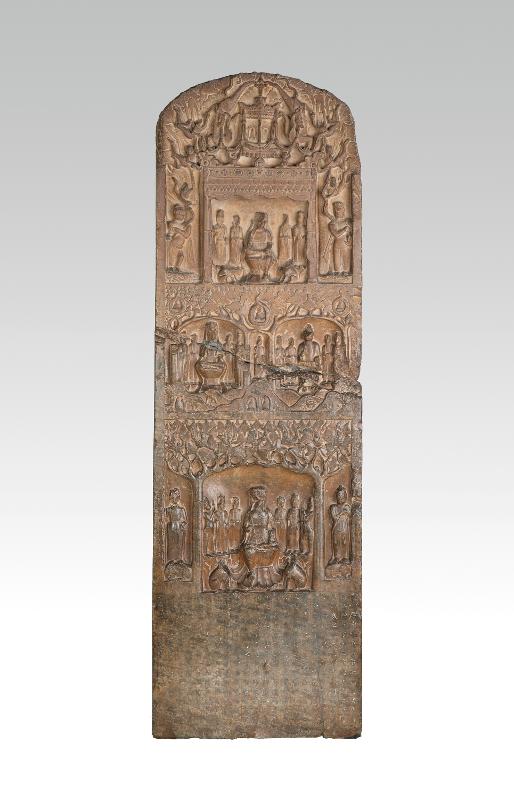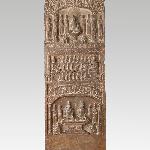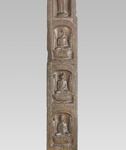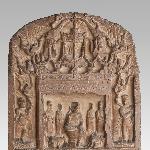Stela
C429
Location: On Display in the Asia Galleries
From: China | Hebei
Curatorial Section: Asian
| Object Number | C429 |
| Current Location | Asia Galleries - On Display |
| Culture | Chinese | Buddhist |
| Provenience | China | Hebei |
| Period | Northern Qi Dynasty |
| Date Made | 575 CE |
| Section | Asian |
| Materials | Stone |
| Technique | Carved |
| Iconography | Buddhas | Sakyamuni Buddha | Prabhutaratna Buddha | Manjusri | Vimalakirti | Bodhisattva | Bodhisattva Maitreya | Attendants | Animals | Dragons | Stupa |
| Inscription Language | Chinese Language |
| Description | Tall thin stela slightly rounded at the top in a dark limestone which has been weathered a golden brown. Both the obverse and reverse are in three registers with niches containing Buddhas and bodhisattvas. The inscription on the obverse gives the date as, "6th year of the Wuping period of the [Northern] Qi Dynasty, fourth moon, eighth day", which corresponds to May 3, 575 CE. The obverse shows Tushita Heaven at the top with Maitreya flanked by monks and bodhisattvas, and Sakyamuni and Prabuhtaratna Buddha in a small stupa above. The scene in the middle depicts a Buddha and a crowned bodhisattva with monks and bodhisattvas on either side. Between them stands a Buddha. Below this is a crowned bodhisattva underneath two trees flanked by monks, bodhisattvas, and pratyekabuddhas. The reverse side depicts Sukhavati, Amitabha Buddha's paradise, at the top, with reborn souls appearing in the foliage above the Buddha. In the center, Vimalakirti, a Buddhist layman, holds a fan as he debates with Manjusri, the Bodhisattva of Wisdom amid a group of seated monks. Below this is a scene from the Lotus Sutra showing Prabhutaratna and Sakyamuni Buddhas preaching together side by side. The sides of the stela show eight Buddhas, a standing Maitreya (with crown) and standing Sakyamuni Buddha with six Buddhas of the Past beneath them (three on each side). This stela probably came from the Xiangtangshan caves in Hebei province. |
| Height | 213.5 cm |
| Width | 62 cm |
| Depth | 25.5 cm |
| Credit Line | Purchased from H. Kevorkian, 1924 |
Report problems and issues to digitalmedia@pennmuseum.org.






